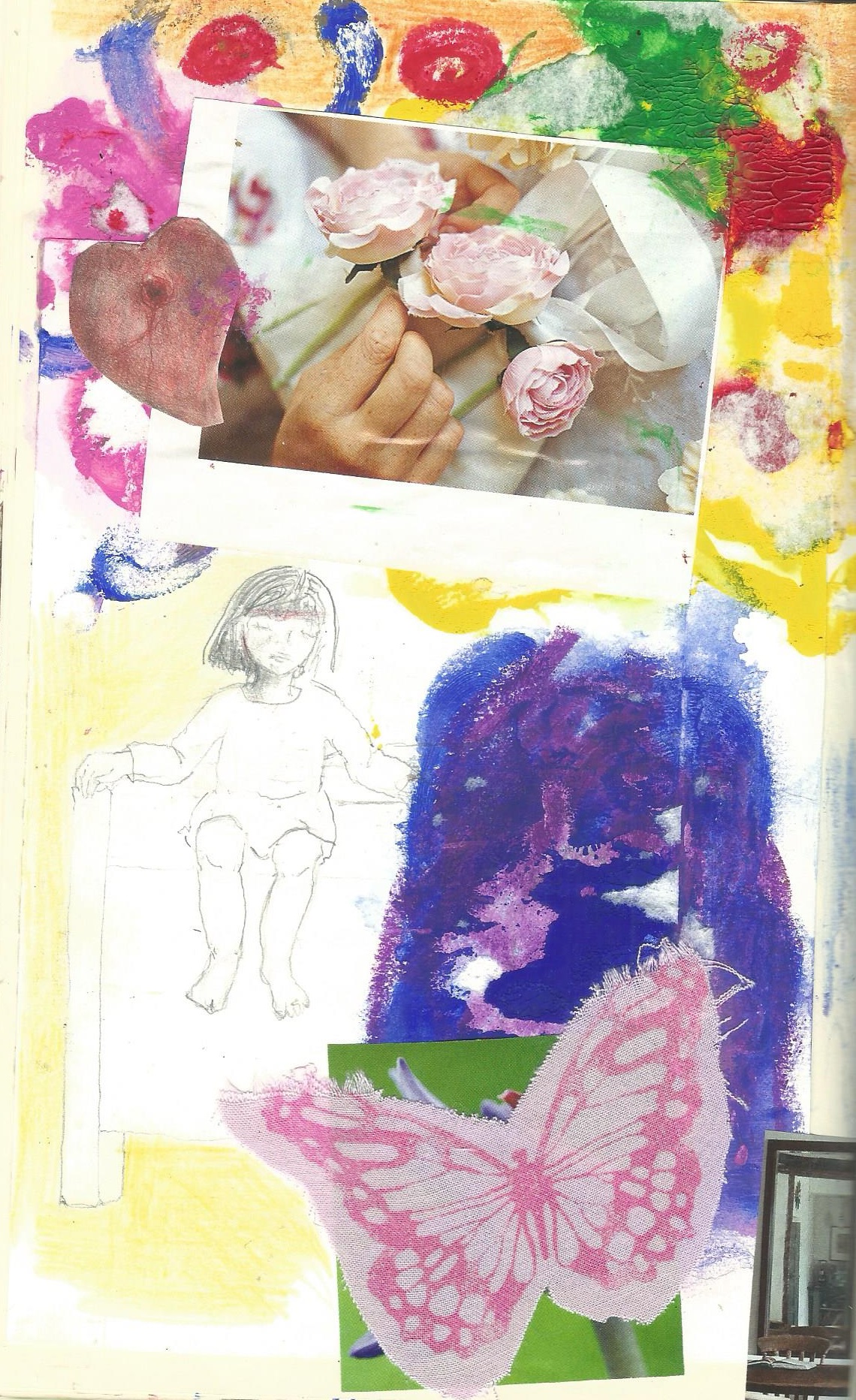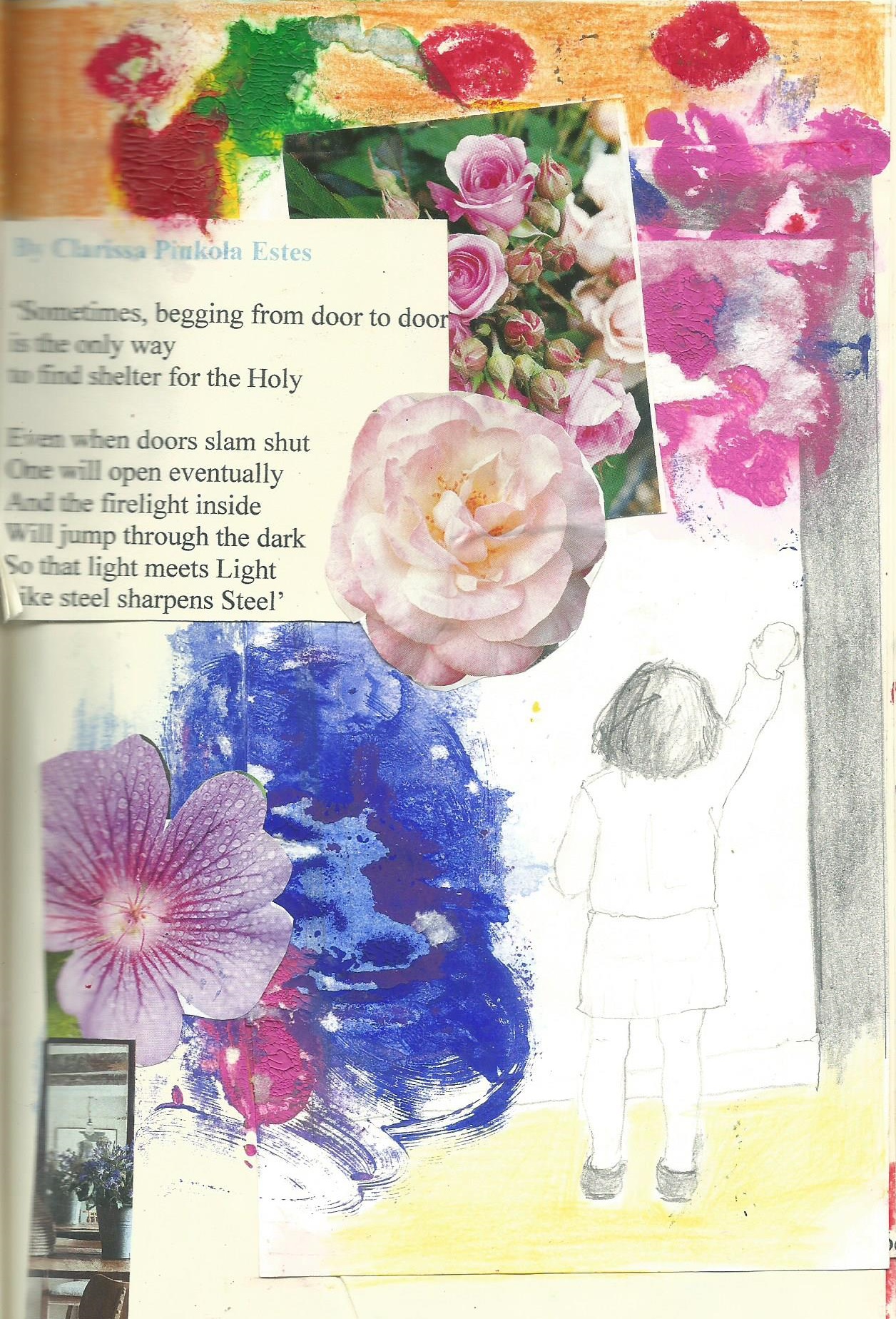Inner maps 
The pictures today are pages from a smash book journal. Smash book type journaling allows me to use any kind of material, have fun crumpling up paper, to be messy, to overcome perfectionist schemas and not focus on end results. When using a pre-existing book or regular notebook, we may need to prep the pages so that we can write, paint and glue. One way of doing this is crumpling up pages and then sticking pages together to make them suitable for gluing or painting. So our journal or book ends up with fewer pages, but much thicker. This particular entry in this smash book has to do with inner child themes and material. It contains a layer of writing, a quick drawing covers the words and then I have added crayons and undiluted acrylic paints using my fingers. Finally, I have glued paper images, a small piece of fabric from a pair of old shorts and a poem by Clarissa Estes Pinkola. In some sense I create shifts in the story and inner experience as I add layers. Interestingly, as I was engaging with this I remembered a chapter in Bessel van der Kolk’s book, The Body Keeps the Score: Mind, Brain and Body in the Transformation of Trauma (chapter 18), in which he refers to the process of RESTRUCTURING INNER MAPS that involves projecting our inner world into the three-dimensional space of a ‘structure’ or tableaux, which enable us to see what’s going on in the theater of our mind, and this, can often give us a clearer perspective. In some sense, our spatial brain via the ‘structure’ allows us to visualize our implicit map of the world.
 Bessel van der Kolk writes that through the process of positioning ‘placeholders’ – that is other people in the group that for a while will represent the important people in our life – we are often surprised by the unexpected memories, thoughts, and emotions that can come up. He writes ‘you can experiment with moving the pieces around on the external chessboard that you’ve created and see what effect it has on you’. In his book he describes how the protagonists become the directors of their own plays and as the narratives unfold, group participants are asked to play the roles of significant people in the protagonists’ lives, such as parents and other family members, friends, etc. So, their inner world takes form in three-dimensional space. Then group members play the wished-for caretakers who could provide the support, love, and protection that had been lacking in past occasions. The psychomotor process allows you to feel what you felt back then, and to say and do what you could not at the time. It’s like going back into the movie of your life and rewriting scenes and creating supplemental memories,
Bessel van der Kolk writes that through the process of positioning ‘placeholders’ – that is other people in the group that for a while will represent the important people in our life – we are often surprised by the unexpected memories, thoughts, and emotions that can come up. He writes ‘you can experiment with moving the pieces around on the external chessboard that you’ve created and see what effect it has on you’. In his book he describes how the protagonists become the directors of their own plays and as the narratives unfold, group participants are asked to play the roles of significant people in the protagonists’ lives, such as parents and other family members, friends, etc. So, their inner world takes form in three-dimensional space. Then group members play the wished-for caretakers who could provide the support, love, and protection that had been lacking in past occasions. The psychomotor process allows you to feel what you felt back then, and to say and do what you could not at the time. It’s like going back into the movie of your life and rewriting scenes and creating supplemental memories,
Maybe one reason I made the association between the type of journaling I described above and the creation of ‘structures’ is the fact that in both cases we can potentially project our inner maps on paper or through the creation of tableaus. These outward projections of our right hemisphere cannot only be quite precise of past dynamics and emotions, as B van der Kolk, suggests, but also allow us to transform old inner narratives by making the invisible visible, and through feeling emotions and harnessing the power of our imagination.
